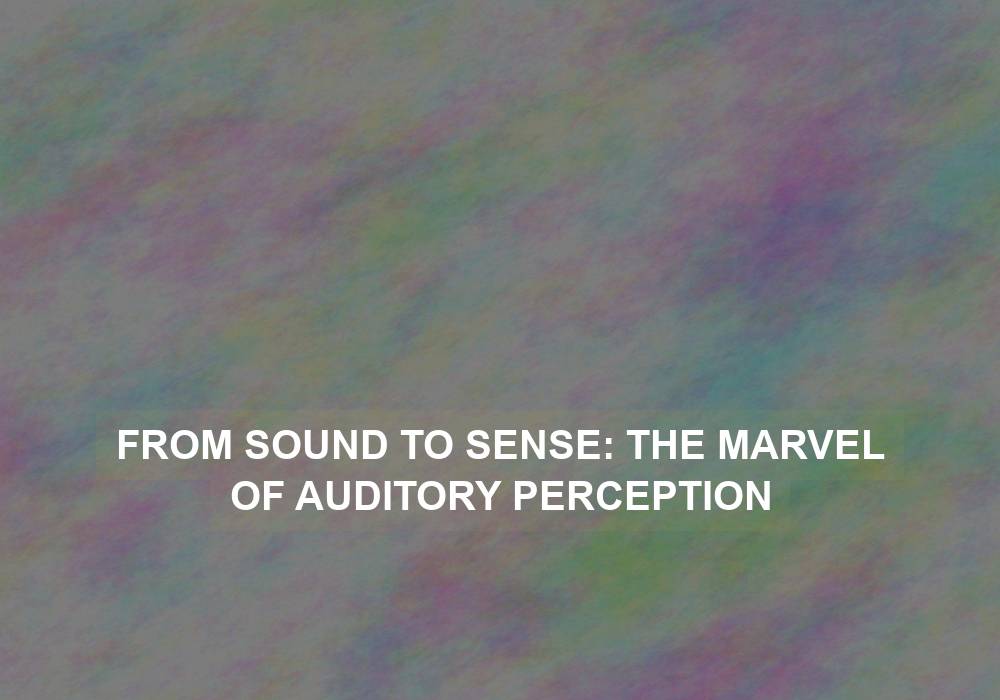Auditory perception, the process by which humans interpret and understand the world through sound, is a truly remarkable feat of our sensory system. It allows us to experience music, communicate with others, and detect potential dangers in our environment. In this article, we will delve into the intricate mechanisms behind auditory perception and explore the fascinating journey of sound waves from our ears to our brain.
Introduction
Auditory perception is a complex process that relies on the intricate anatomy of the ear and the brain’s ability to interpret electrical signals. Through this process, we are able to make sense of the sounds around us and gain a deeper understanding of our environment.
The Anatomy of Hearing
To fully grasp auditory perception, it is important to understand the three main parts of our auditory system: the outer ear, the middle ear, and the inner ear.
The Outer Ear
The outer ear consists of the pinna, or the visible part of the ear, and the ear canal. The pinna acts as a funnel, capturing sound waves and directing them into the ear canal. From there, the sound waves travel towards the eardrum.
The Middle Ear
The eardrum serves as the boundary between the outer and middle ear. When sound waves reach the eardrum, they cause it to vibrate. These vibrations are then transmitted through a chain of three tiny bones called the ossicles: the malleus (hammer), incus (anvil), and stapes (stirrup). The ossicles amplify and transmit the vibrations to the inner ear.
The Inner Ear
The inner ear is a complex structure responsible for converting sound waves into electrical signals that can be interpreted by the brain. At the core of the inner ear lies the cochlea, a snail-shaped organ filled with fluid and lined with specialized hair cells. When the vibrations from the ossicles reach the cochlea, they cause the fluid to move, stimulating the hair cells. These hair cells convert the mechanical energy of the vibrations into electrical signals, which are then transmitted to the brain via the auditory nerve.
Auditory Perception Process
Once the electrical signals reach the brain, a series of intricate processes take place to interpret and make sense of the sound. Let’s explore the journey of auditory perception in more detail.
Sound Localization
One remarkable ability of our auditory system is sound localization. Through the combined efforts of our ears, brain, and auditory system, we can determine the origin and direction of a sound source. This ability helps us navigate our environment, identify potential threats, and engage in conversations. Sound localization relies on several factors, including the slight time delay between when a sound reaches each ear and the differences in sound intensity and frequency.
Auditory Processing in the Brain
After the electrical signals from the cochlea reach the brain, they are processed in various regions, including the auditory cortex. The auditory cortex is responsible for interpreting the different aspects of sound, such as pitch, rhythm, and timbre. This processing allows us to recognize and distinguish between various sounds, including language, music, and environmental noises. The brain’s ability to analyze and interpret these auditory signals is truly remarkable.
Language Processing
Language processing is a crucial aspect of auditory perception. It involves the understanding and interpretation of spoken words and sentences. The brain’s language centers, such as Broca’s area and Wernicke’s area, play a significant role in this process. They enable us to comprehend the meaning of words, construct coherent sentences, and facilitate effective communication. Language processing is a complex interplay between auditory perception and cognitive processes.
Music Perception
Music is a universal language that can evoke powerful emotions and elicit profound responses in individuals. Auditory perception plays a vital role in our enjoyment and appreciation of music. The brain’s auditory processing regions analyze the various elements of music, such as melody, harmony, and rhythm, allowing us to experience the beauty and complexity of musical compositions. Our ability to perceive music is shaped by our auditory system’s ability to process and interpret the intricate patterns of sound.
Auditory Perception and Emotions
Sound has a profound impact on our emotions. Certain sounds, such as laughter or soothing music, can evoke feelings of happiness and relaxation. Conversely, loud and sudden noises may trigger fear or anxiety. Auditory perception is closely tied to our emotional responses, highlighting the intricate connection between sound and our overall well-being. The ability to perceive and interpret sound is a fundamental aspect of human experience and greatly influences our emotional state.
Conclusion
Auditory perception is a remarkable process that allows us to interact with our environment, understand language, appreciate music, and experience a range of emotions. From the capturing of sound waves by our ears to the interpretation and processing in our brains, the journey of auditory perception is a testament to the marvels of the human sensory system. Understanding the intricacies of auditory perception enhances our appreciation for this incredible sense and its role in shaping our perception of the world around us.
